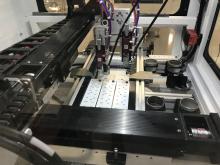Submitted by Siteguru on Mon, 08/28/2017 - 12:28

A few weeks ago, I shared an article that explained the basics of conformal coatings. The article provided a brief description of the benefits of coatings, with the most obvious benefit being, they create a barrier between sensitive surface mount device and the environment in which they function. I also mentioned some additional protections they provide, such as protecting solder contacts from thermal and mechanical shock, and corrosion. Additionally, they add strength and insulating properties to component connections. The advantage that most electronics engineers appreciate is the insulating properties, which allows engineers to better utilize small board space and place components in close proximity, knowing the coating will protect against unintended conduction of heat and/or voltage on today's’ densely packed printed circuit boards. Today I want to go a bit further and share information on how and why coatings are selected and a little about a new and very specific type of coating.
How are coating selected
When engineers and designers begin working on a new project, there are a number of factors they must ponder, but for the purpose of this article, we will focus on printed circuit board protection. Considerations specific to the protection of a printed circuit board may look like this; What are the typical uses of the product? In what environment will the finished product be expected to perform? How can our design make the most of the available space, provide proper functionality and component protection in the anticipated environment? How and where will the board be mounted/secured? How will it be housed?...
In some circumstances, the environment may be an office, where the product sits on a desk, it is climate-controlled and temperature and moisture fluctuations are minimal. These boards require very little additional protections. On the other end of the spectrum are products that have to function in a wide range of temperatures, moisture fluctuation, and/or exposure to chemicals and environmental debris. They may need to function in environments as extreme as fire fighters fighting fires to disaster relief efforts during a hurricane. These products may often get dropped or bounced around on a regular basis and their electronic components have to remain functional, or it could cost lives. So, engineers use a lot of data to determine how to best design electronic devices so they fit well in their environment and they function properly for the expected use and life cycle of the product.
What About Resins?
One of the newer and lesser known printed circuit board coatings is two-part polyurethane and epoxy coatings, typically referred to as resins. PROS - These types of coatings have superior protective qualities. They can be applied just as other more common types of coatings, but they cure without any additional process when applied in the proper ratios. They provide excellent protections to boards in harsh environments where the board is not encased in a moisture tight protective housing. However, resins have been used on boards that are encased in a watertight protective housing as a secondary layer of ultimate protection. When environments are harsh and a broken seal could jeopardize product function, a resin coating can add another layer of protection when product failure is not an option. When applied correctly, the coating is significantly thicker than common acrylic coatings, so they provide better protection from chemical exposure and mechanical and/or thermal shock. CONS – Resins cost considerably more. They also add additional weight to the boards and are nearly impossible to remove without causing harm to the board components. So, repairs usually mean a new board.
Other Uses
There are also a couple of additional uses for resins that are outside the normal scope of conformal coating functions. Since they cannot be removed without damage, they are being used for tamper prevention. If the resin is tampered with or removed, the board will fail to function. You can also get colored resins that will protect your intellectual property by hiding components under a mask. It will be interesting to see the continued evolution of coatings and electronics. Companies continue the race to create the most innovative products on the market, and in doing so, often cannibalize their own products in the process. I will not be surprised to see small electronic devices that are considered disposable, with the electronics completely encapsulated in an opaque coating, all in an effort to protect intellectual property and slow the rate of obsolescence.
